Development of Land-Use/Land-Cover Maps Using Landsat-8 and MODIS Data, and Their Integration for Hydro-Ecological Applications
Abstract
1. Introduction
2. Materials and Methods
2.1. The Study Area
2.2. Data Requirements
3. Methods
3.1. Generating the Preliminary LULC Map
3.2. Rectifying the Mixed Classes
3.2.1. Rectifying Vegetation Classes
3.2.2. Rectifying Developed, Exposed Land, and Agriculture Classes
3.3. Generating the Final LULC Map by Integrating the Rectifications
3.4. Validating the Final LULC Map
3.5. Preparing the Hydro-Ecological Maps
4. Results and Discussion
4.1. Final LULC Map
4.2. Validation of the Final LULC Map
4.3. Hydro-Ecological Maps
4.4. Potential Applications of the Hydro-Ecological Maps
5. Conclusions
Author Contributions
Funding
Acknowledgments
Conflicts of Interest
References
- Homer, C.G.; Dewitz, J.; Yang, L.; Jin, S.; Danielson, P.; Xian, G.; Coulston, J.W.; Herold, N.D.; Wickham, J.D.; Megown, K. Completion of the 2011 National Land Cover Database for the Conterminous United States—Representing a Decade of Land Cover Change Information. Program. Eng. Remote Sens. 2015, 81, 345–354. [Google Scholar]
- Chen, L.; Sun, Y.; Saeed, S. Monitoring and predicting land use and land cover changes using remote sensing and GIS techniques—A case study of a hilly area, Jiangle, China. PLoS ONE 2018, 13, e0200493. [Google Scholar] [CrossRef]
- Natural Resources Canada. Land Cover & Land Use. Available online: https://www.nrcan.gc.ca/node/9373 (accessed on 15 September 2018).
- Chowdhury, S.; Chao, D.K.; Shipman, T.C.; Wulder, M.A. Utilization of Landsat data to quantify land-use and land-cover changes related to oil and gas activities in West-Central Alberta from 2005 to 2013. GIScience Remote Sens. 2017, 54, 700–720. [Google Scholar] [CrossRef]
- Gillanders, S.N.; Coops, N.C.; Wulder, M.A.; Goodwin, N.R. Application of Landsat satellite imagery to monitor land-cover changes at the Athabasca Oil Sands, Alberta, Canada. Can. Geogr. 2008, 52, 466–485. [Google Scholar] [CrossRef]
- Lower Athabasca Regional Plan 2012–2022; Government of Alberta: Edmonton, AB, Canada, 2012.
- Abdollahi, M.; Islam, T.; Gupta, A.; Hassan, Q. An Advanced Forest Fire Danger Forecasting System: Integration of Remote Sensing and Historical Sources of Ignition Data. Remote Sens. 2018, 10, 923. [Google Scholar] [CrossRef]
- Castilla, G.; Hay, G.J. Uncertainties in land use data. Hydrol. Earth Syst. Sci. 2007, 11, 1857–1868. [Google Scholar] [CrossRef]
- Farjad, B.; Pooyandeh, M.; Gupta, A.; Motamedi, M.; Marceau, D. Modelling interactions between land use, climate, and hydrology along with stakeholders’ negotiation for water resources management. Sustainability 2017, 9, 2022. [Google Scholar] [CrossRef]
- Nie, W.; Yuan, Y.; Kepner, W.; Nash, M.S.; Jackson, M.; Erickson, C. Assessing impacts of Landuse and Landcover changes on hydrology for the upper San Pedro watershed. J. Hydrol. 2011, 407, 105–114. [Google Scholar] [CrossRef]
- Welde, K.; Gebremariam, B. Effect of land use land cover dynamics on hydrological response of watershed: Case study of Tekeze Dam watershed, northern Ethiopia. Int. Soil Water Conserv. Res. 2017, 5, 1–16. [Google Scholar] [CrossRef]
- Zhu, C.; Li, Y. Long-Term Hydrological Impacts of Land Use/Land Cover Change From 1984 to 2010 in the Little River Watershed, Tennessee. Int. Soil Water Conserv. Res. 2014, 2, 11–21. [Google Scholar] [CrossRef]
- Koneti, S.; Sunkara, S.; Roy, P. Hydrological Modeling with Respect to Impact of Land-Use and Land-Cover Change on the Runoff Dynamics in Godavari River Basin Using the HEC-HMS Model. ISPRS Int. J. Geo-Inf. 2018, 7, 206. [Google Scholar] [CrossRef]
- Bhaduri, B.; Harbor, J.; Engel, B.; Grove, M. Assessing watershed-scale, long-term hydrologic impacts of land-use change using a GIS-NPS model. Environ. Manag. 2000, 26, 643–658. [Google Scholar] [CrossRef] [PubMed]
- Regional Aquatics Monitoring Program (RAMP). Potential Effects of Oil Sands on Aquatic Ecosystems. Available online: http://www.ramp-alberta.org/resources/development/upgrading.aspx (accessed on 15 September 2018).
- Natural Resources Canada. Oil Sands: Water Management. A Strategic Resource for Canada, North America and the Global Market. Available online: https://www.nrcan.gc.ca/energy/publications/18750 (accessed on 15 September 2018).
- Alberta Energy Regulator (AER). Oil Sands Mining Water Use Report Summary. Available online: https://www.aer.ca/protecting-what-matters/holding-industry-accountable/industry-performance/water-use-performance (accessed on 8 August 2019).
- Jordaan, S.M. Land and Water Impacts of Oil Sands Production in Alberta. Environ. Sci. Technol. 2012, 46, 3611–3617. [Google Scholar] [CrossRef] [PubMed]
- Castilla, G.; Hird, J.; Hall, R.J.; Schieck, J.; McDermid, G.J. Completion and Updating of a Landsat-Based Land Cover Polygon Layer for Alberta, Canada. Can. J. Remote Sens. 2014, 40, 92–109. [Google Scholar] [CrossRef]
- Abdullah, A.Y.M.; Masrur, A.; Adnan, M.S.G.; Baky, M.A.A.; Hassan, Q.K.; Dewan, A. Spatio-temporal patterns of land use/land cover change in the heterogeneous coastal region of Bangladesh between 1990 and 2017. Remote Sens. 2019, 11, 790. [Google Scholar] [CrossRef]
- Akbar, T.A.; Hassan, Q.K.; Ishaq, S.; Batool, M.; Butt, H.J.; Jabbar, H. Investigative spatial distribution and modelling of existing and future urban land changes and its impact on urbanization and economy. Remote Sens. 2019, 11, 105. [Google Scholar] [CrossRef]
- Stow, D.A.; Chen, D.M. Sensitivity of multitemporal NOAA AVHRR data of an urbanizing region to land-use/land-cover changes and misregistration. Remote Sens. Environ. 2002, 80, 297–307. [Google Scholar] [CrossRef]
- Verburg, P.H.; Neumann, K.; Nol, L. Challenges in using land use and land cover data for global change studies. Glob. Chang. Biol. 2011, 17, 974–989. [Google Scholar] [CrossRef]
- Rogan, J.; Chen, D.M. Remote sensing technology for mapping and monitoring land-cover and land-use change. Prog. Plan. 2004, 61, 301–325. [Google Scholar] [CrossRef]
- Wulder, M.A.; White, J.C.; Loveland, T.R.; Woodcock, C.E.; Belward, A.S.; Cohen, W.B.; Fosnight, E.A.; Shaw, J.; Masek, J.G.; Roy, D.P. The global Landsat archive: Status, consolidation, and direction. Remote Sens. Environ. 2016, 185, 271–283. [Google Scholar] [CrossRef]
- European Environment Agency. CLC2006 Technical Guidelines; European Environment Agency: Copenhagen, 2010; Volume 2010, ISBN 9789291679683. [Google Scholar]
- Rowland, C.S.; Morton, R.D.; Carrasco, L.; McShane, G.; O′Neil, A.W.; Wood, C.M. Land Cover Map 2015 (25m Raster GB); Centre for Ecology & Hydrology, Natural Environment Research Council: Bailrigg, UK, 2017. [Google Scholar]
- Latifovic, R.; Pouliot, D.; Olthof, I. Circa 2010 land cover of Canada: Local optimization methodology and product development. Remote Sens. 2017, 9, 1–18. [Google Scholar] [CrossRef]
- Wulder, M.A.; White, J.C.; Cranny, M.; Hall, R.J.; Luther, J.E.; Beaudoin, A.; Goodenough, D.G.; Dechka, J.A. Monitoring Canada′s forests. Part 1: Completion of the EOSD land cover project. Can. J. Remote Sens. 2008, 34, 549–562. [Google Scholar] [CrossRef]
- Agriculture and Agri-Foods Canada (AAFC). Land Use 1990, 2000 & 2010. Open Government Portal: Government of Canada; Agriculture and Agri-Foods Canada: Mount Pearl, NL, Canada. Available online: https://open.canada.ca/data/en/dataset/18e3ef1a-497c-40c6-8326-aac1a34a0dec (accessed on 15 September 2018).
- Alberta Biodiversity Monitoring Institute. ABMI Wall-to-wall Land Cover Map 2010. version 1.1. Available online: https://abmi.ca/home/data-analytics/da-top/da-product-overview/Data-Archive/Land-Cover.html (accessed on 15 September 2018).
- Akhtar, F.; Awan, U.K.; Tischbein, B.; Liaqat, U.W. A phenology based geo-informatics approach to map land use and land cover (2003–2013) by spatial segregation of large heterogenic river basins. Appl. Geogr. 2017, 88, 48–61. [Google Scholar] [CrossRef]
- Yan, E.; Wang, G.; Lin, H.; Xia, C.; Sun, H. Phenology-based classification of vegetation cover types in Northeast China using MODIS NDVI and EVI time series. Int. J. Remote Sens. 2015, 36, 489–512. [Google Scholar] [CrossRef]
- Tondu, J.; Rowell, P. State of the Athabasca Watershed: Summary Report 2018; Athabasca Watershed Council: Athabasca, AB, Canada, 2018. [Google Scholar]
- Natural Regions Committee 2006. Natural Regions and Subregions of Alberta; Publication No. T/852; Downing, D.J., Pettapiece, W.W., Eds.; Government of Alberta: Edmonton, AB, Canada, 2006; ISBN 0778545725.
- CAPP. A Competitive Policy and Regulatory Framework of Alberta′s Upstream Oil and Natural Gas Industry; Publication 2017-0035; Canadian Association of Petroleum Producers: Calgary, AB, Canada, 2017; p. 49. [Google Scholar]
- Ahmed, M.; Rahaman, K.; Hassan, Q. Remote Sensing of Wildland Fire-Induced Risk Assessment at the Community Level. Sensors 2018, 18, 1570. [Google Scholar] [CrossRef]
- Alberta Biodiversity Monitoring Institute and Alberta Human Footprint Monitoring Program. Human Footprint Inventory 2016; Version 1; Alberta Biodiversity Monitoring Institute: Edmonton, AB, Canada, 2017; p. 202. [Google Scholar]
- Castilla, G.; Crane, D.; Hirdand, J.; McDermid, G.; Maynes, B. ABMI 3X7 Photoplot Land Cover Dataset Data Model; Version 2.4.1.; ABMI Geospatial Centre, Alberta Biodiversity Monitoring Institute: Edmonton, AB, Canada, 2016. [Google Scholar]
- Alberta Environment and Parks (AEP). Alberta Merged Wetland Inventory; Government of Alberta: Edmonton, AB, Canada, 2017. [Google Scholar]
- Schriever, J.; Congalton, R. Evaluating Seasonal Variablity as an Aid to Cover-Type Mapping from Landsat Thematic Mapper Data in the Northwest. Photogramm. Eng. Remote Sens. 1995, 61, 321–327. [Google Scholar]
- Franklin, S.E.; Wulder, M.A. Remote sensing methods in medium spatial resolution satellite data land cover classification of large areas. Prog. Phys. Geogr. 2002, 26, 173–205. [Google Scholar] [CrossRef]
- Ahmed, B.; Kamruzzaman, M.; Zhu, X.; Rahman, M.; Choi, K. Simulating Land Cover Changes and Their Impacts on Land Surface Temperature in Dhaka, Bangladesh. Remote Sens. 2013, 5, 5969–5998. [Google Scholar] [CrossRef]
- Pielke, R.A.; Marland, G.; Betts, R.A.; Chase, T.N.; Eastman, J.L.; Niles, J.O.; Niyogi, D.D.S.; Running, S.W. The influence of land-use change and landscape dynamics on the climate system: Relevance to lcimate-change policy beyond the radiative effect of greenhouse gases. Philos. Trans. A Math. Phys. Eng. Sci. 2002, 360, 1705–1719. [Google Scholar] [CrossRef]
- Buck, O.; Niyogi, D.K.; Townsend, C.R. Scale-dependence of land use effects on water quality of streams in agricultural catchments. Environ. Pollut. 2004, 130, 287–299. [Google Scholar] [CrossRef]
- Zomlot, Z.; Verbeiren, B.; Huysmans, M.; Batelaan, O. Trajectory analysis of land use and land cover maps to improve spatial–temporal patterns, and impact assessment on groundwater recharge. J. Hydrol. 2017, 554, 558–569. [Google Scholar] [CrossRef]
- Superczynski, S.D.; Christopher, S.A. Exploring land use and land cover effects on air quality in Central Alabama using GIS and remote sensing. Remote Sens. 2011, 3, 2552–2567. [Google Scholar] [CrossRef]
- Dewan, A.M.; Yamaguchi, Y. Using remote sensing and GIS to detect and monitor land use and land cover change in Dhaka Metropolitan of Bangladesh during 1960–2005. Environ. Monit. Assess. 2009, 150, 237–249. [Google Scholar] [CrossRef] [PubMed]
- Hermosilla, T.; Wulder, M.A.; White, J.C.; Coops, N.C.; Hobart, G.W. Disturbance-Informed Annual Land Cover Classification Maps of Canada’s Forested Ecosystems for a 29-Year Landsat Time Series. Can. J. Remote Sens. 2018, 44, 67–87. [Google Scholar] [CrossRef]
- Plieninger, T. Habitat loss, fragmentation, and alteration—Quantifying the impact of land-use changes on a Spanish dehesa landscape by use of aerial photography and GIS. Landsc. Ecol. 2006, 21, 91–105. [Google Scholar] [CrossRef]
- Price, J.S.; Waddington, J.M. Advances in Canadian wetland hydrology and biogeochemistry. Hydrol. Process. 2000, 14, 1579–1589. [Google Scholar] [CrossRef]
- Mamuji, A.A.; Rozdilsky, J.L. Wildfire as an increasingly common natural disaster facing Canada: Understanding the 2016 Fort McMurray wildfire. Nat. Hazards 2018, 98, 163–180. [Google Scholar] [CrossRef]
- Landis, M.S.; Edgerton, E.S.; White, E.M.; Wentworth, G.R.; Sullivan, A.P.; Dillner, A.M. The impact of the 2016 Fort McMurray Horse River Wildfire on ambient air pollution levels in the Athabasca Oil Sands Region, Alberta, Canada. Sci. Total Environ. 2018, 618, 1665–1676. [Google Scholar] [CrossRef]
- Ice, G.G.; Neary, D.G.; Adams, P.W. Effects of Wildfire on Soils and Watershed Processes. J. For. 2004, 102, 4–8. [Google Scholar]
- Whiteman, M.; José, P.; Grout, M.; Brooks, A.; Quinn, S.; Acreman, M. Local impact assessment of wetlands—From hydrological impact to ecological effects. Hydrol. Sci. Pract. 21st Century 2004, II, 198–212. [Google Scholar]
- Farjad, B.; Gupta, A.; Razavi, S.; Faramarzi, M.; Marceau, D. An integrated modelling system to predict hydrological processes under climate and land-use/cover change scenarios. Water 2017, 9, 767. [Google Scholar] [CrossRef]
- Weatherhead, E.K.; Howden, N.J.K. The relationship between land use and surface water resources in the UK. Land Use Policy 2009, 26, S243–S250. [Google Scholar] [CrossRef]
- Dias, L.C.P.; Macedo, M.N.; Costa, M.H.; Coe, M.T.; Neill, C. Effects of land cover change on evapotranspiration and streamflow of small catchments in the Upper Xingu River Basin, Central Brazil. J. Hydrol. Reg. Stud. 2015, 4, 108–122. [Google Scholar] [CrossRef]
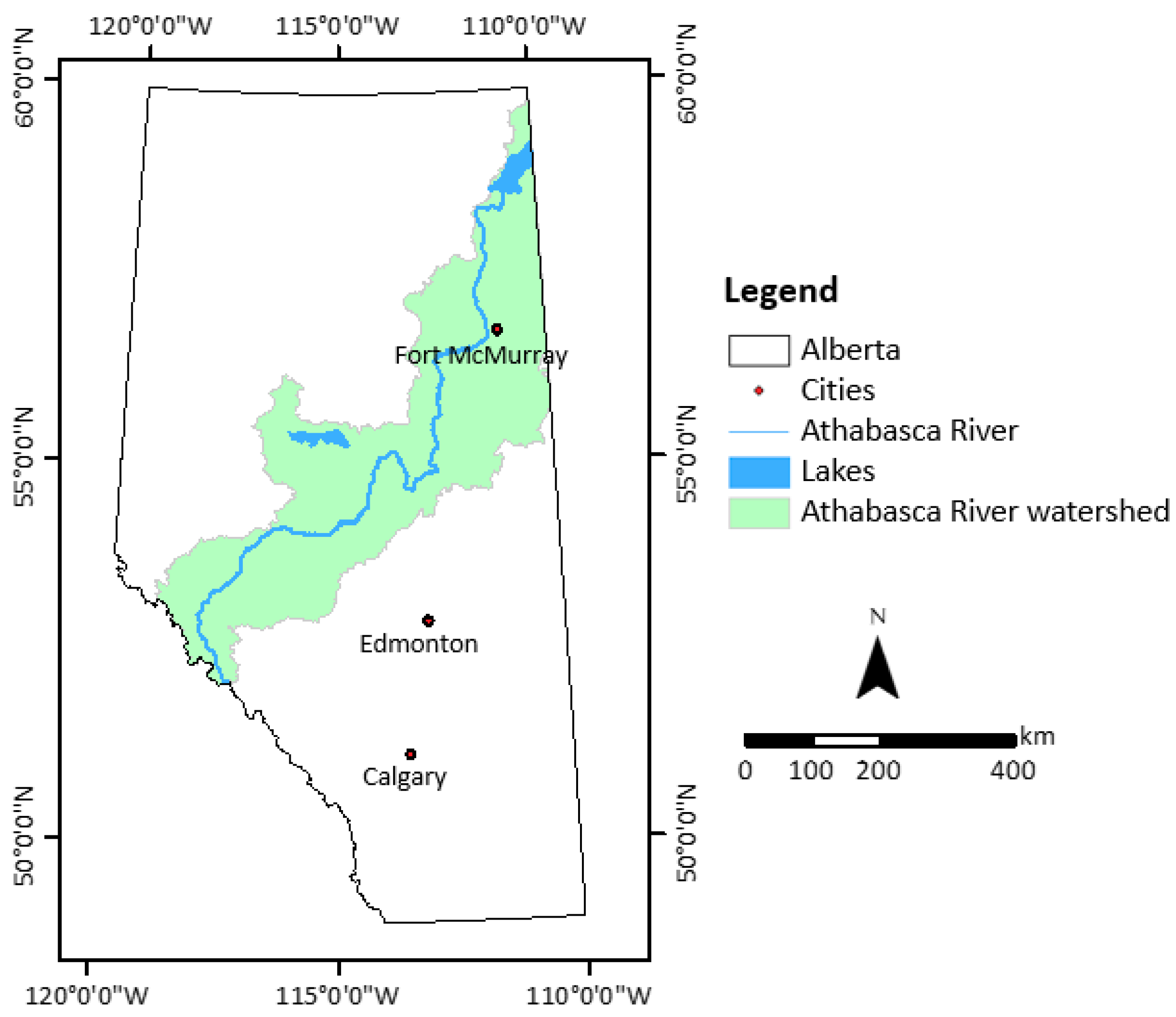

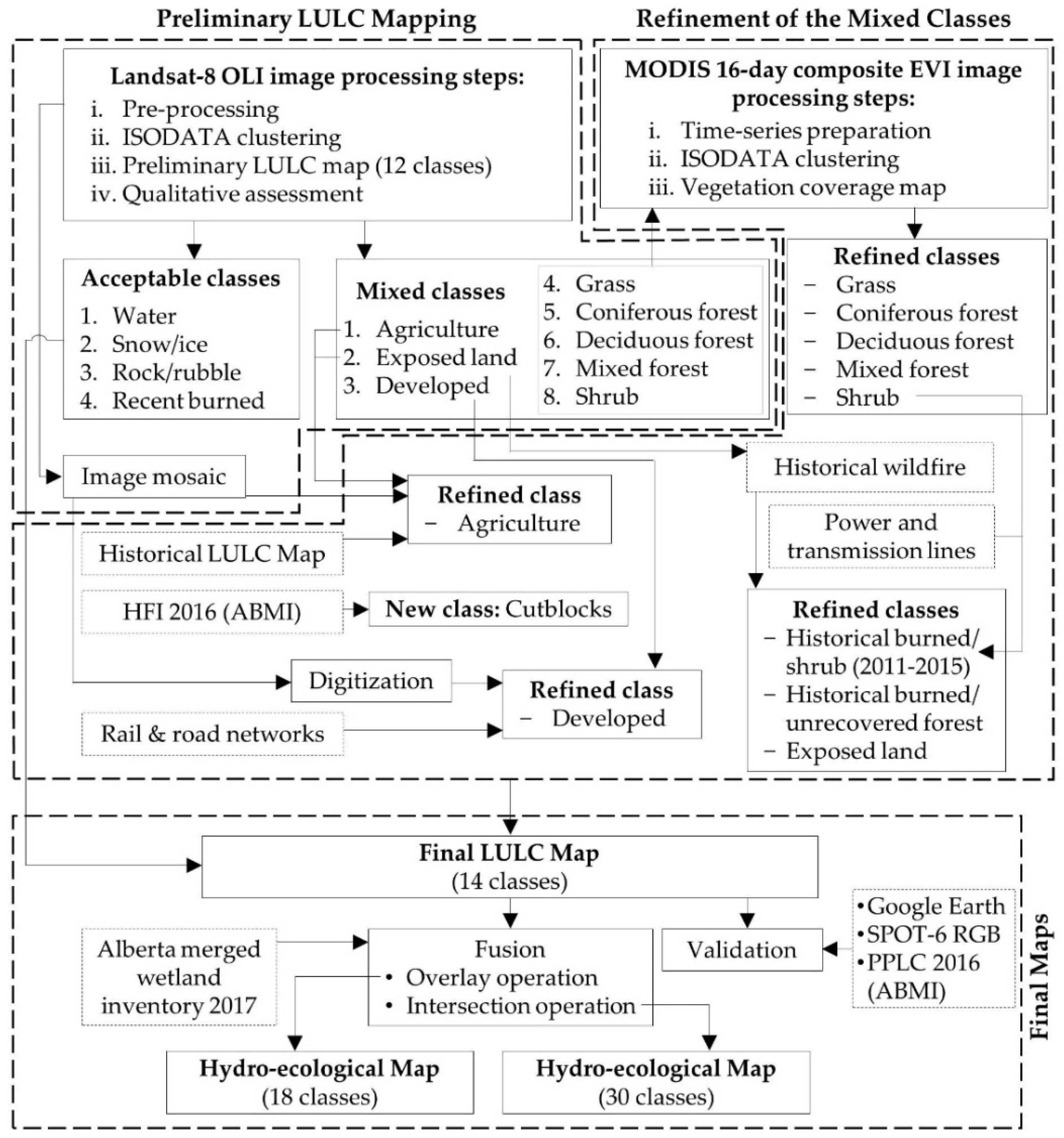
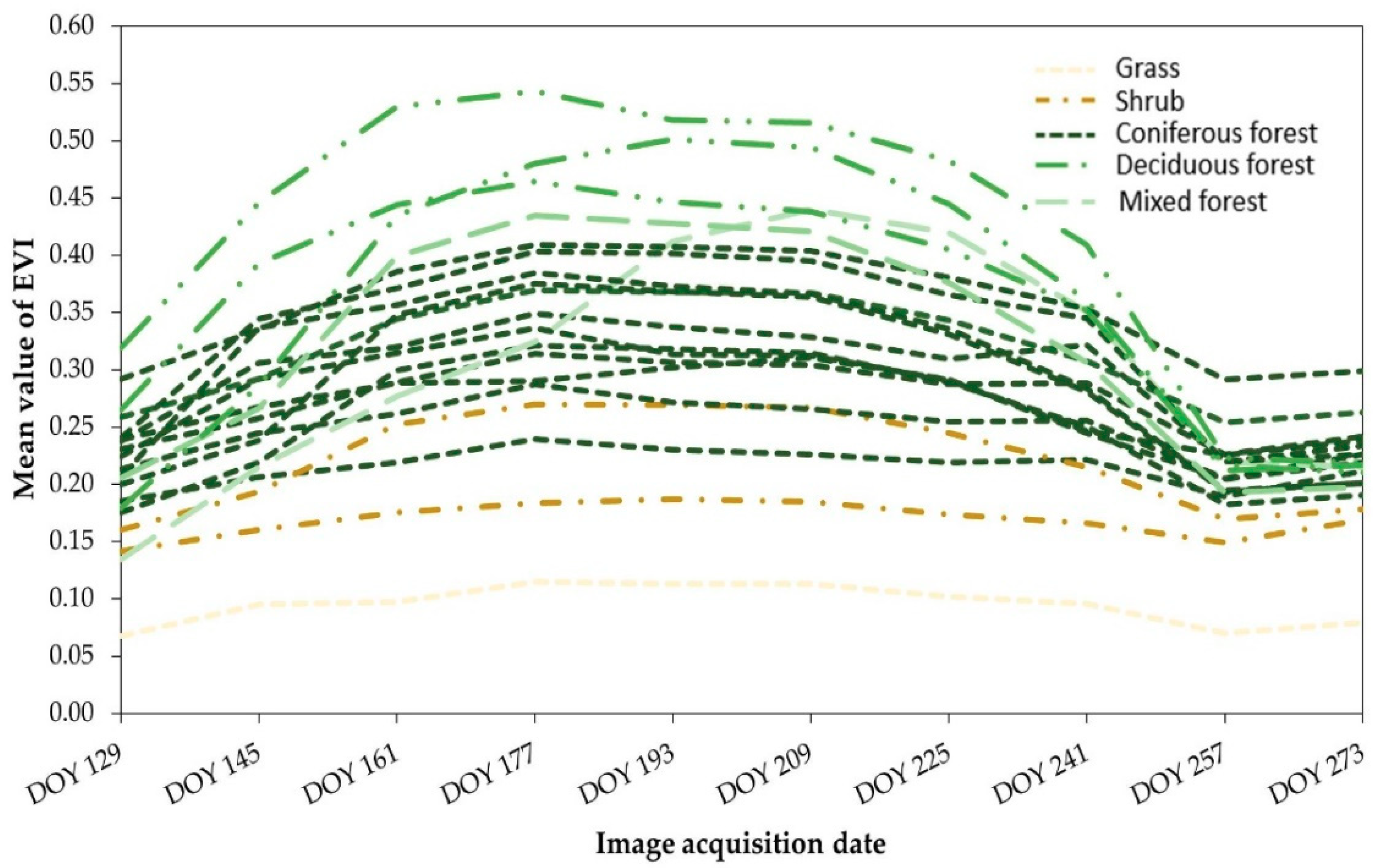
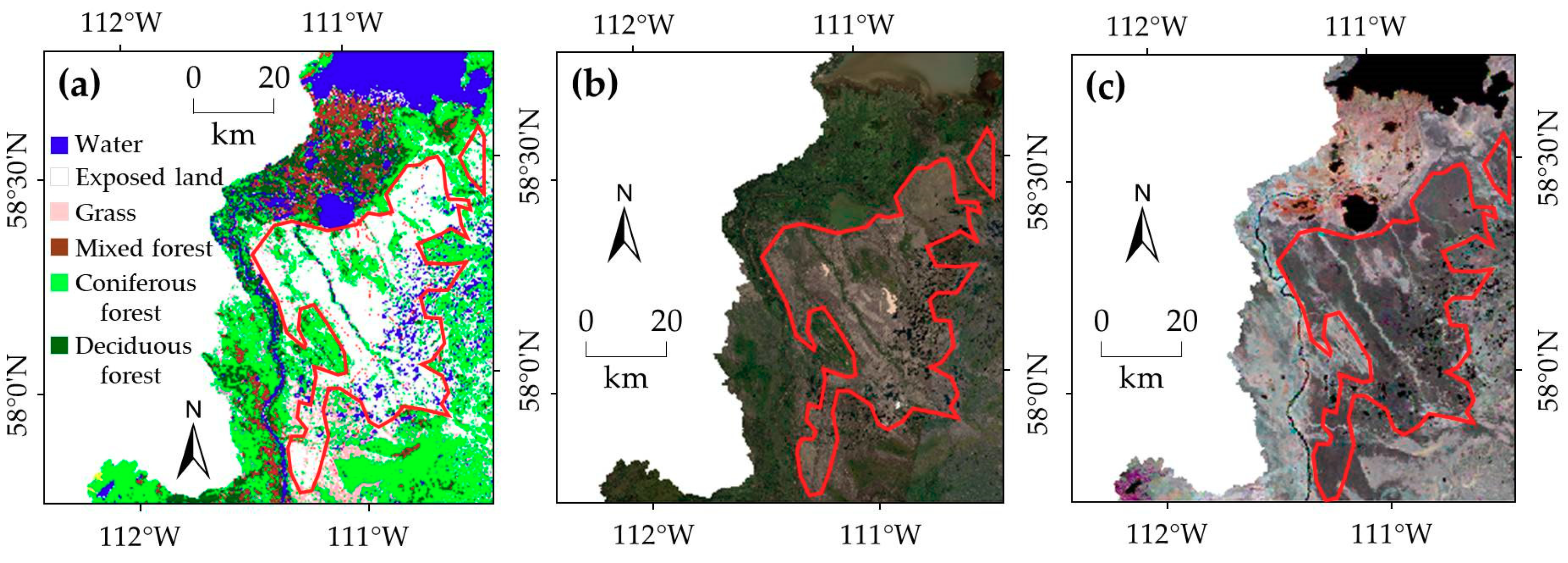


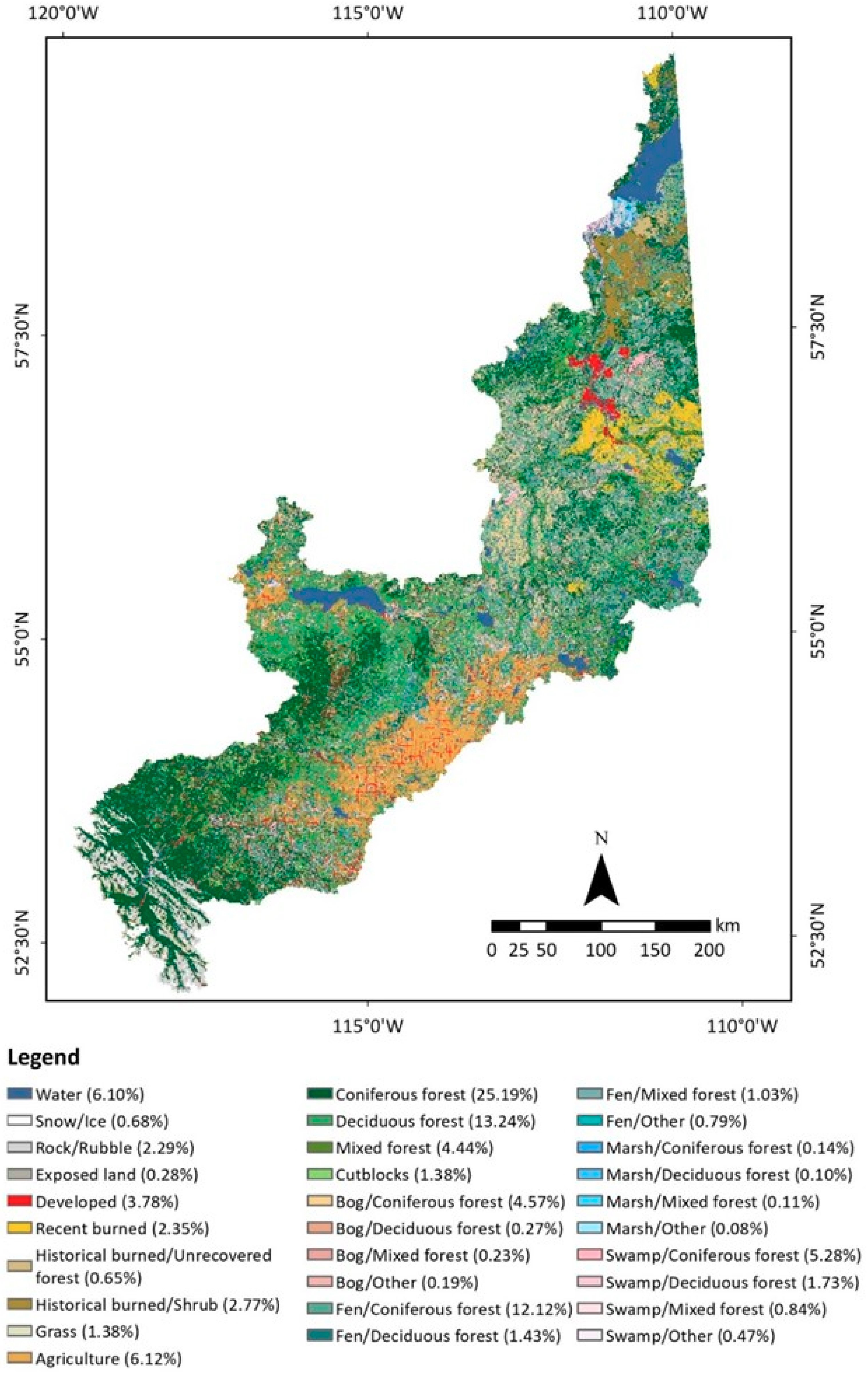
| LULC Class | Reference Area (km2) | Total Area (km2) | Percentage (%) |
|---|---|---|---|
| Water | 182 | 9171 | 1.98 |
| Snow/ice | 11 | 1041 | 1.02 |
| Rock/rubble | 36 | 3472 | 1.02 |
| Exposed land | 10 | 980 | 1.01 |
| Developed | 118 | 5255 | 2.24 |
| Recent burned | 71 | 3541 | 1.99 |
| Historical burned/shrub | 66 | 5215 | 1.27 |
| Grass | 10 | 930 | 1.03 |
| Agriculture | 189 | 9786 | 1.93 |
| Coniferous forest | 746 | 73,531 | 1.01 |
| Deciduous forest | 460 | 26,910 | 1.71 |
| Mixed forest | 162 | 10,426 | 1.56 |
| Total | 2,060 | 150,256 | 1.37 |
| LULC Class | Water | Snow/ice | Rock/Rubble | Exposed Land | Developed | Recent Burned | Historical Burned/Shrub | Grass | Agriculture | Coniferous Forest | Deciduous Forest | Mixed Forest | Row Total | User’s Accuracy |
|---|---|---|---|---|---|---|---|---|---|---|---|---|---|---|
| Water | 189,274 | 0 | 37 | 0 | 1550 | 24 | 896 | 0 | 154 | 5363 | 4965 | 2109 | 204,372 | 93% |
| Snow/ice | 0 | 10,747 | 765 | 0 | 0 | 0 | 0 | 8 | 0 | 51 | 0 | 0 | 11,571 | 93% |
| Rock/rubble | 4 | 1007 | 36,358 | 0 | 0 | 0 | 0 | 228 | 0 | 863 | 0 | 0 | 38,460 | 95% |
| Exposed land | 207 | 0 | 0 | 10,214 | 133 | 0 | 160 | 4 | 483 | 7108 | 1199 | 1158 | 20,666 | 49% |
| Developed | 187 | 0 | 0 | 0 | 123,597 | 1 | 131 | 0 | 2856 | 9018 | 13,074 | 4506 | 153,370 | 81% |
| Recent burned | 0 | 0 | 0 | 0 | 110 | 71,907 | 1007 | 0 | 0 | 71 | 6 | 64 | 73,165 | 98% |
| Historical Burned/Shrub | 3003 | 0 | 108 | 384 | 830 | 3829 | 67,715 | 72 | 0 | 33,087 | 3215 | 2494 | 114,737 | 59% |
| Grass | 382 | 38 | 1808 | 37 | 42 | 0 | 81 | 10,034 | 0 | 5716 | 388 | 304 | 18,830 | 53% |
| Agriculture | 46 | 0 | 0 | 0 | 606 | 0 | 0 | 0 | 200,195 | 521 | 8083 | 832 | 210,283 | 95% |
| Coniferous forest | 6166 | 0 | 405 | 405 | 2542 | 307 | 2700 | 269 | 1572 | 673,284 | 131,912 | 81,212 | 900,774 | 75% |
| Deciduous forest | 1562 | 0 | 0 | 0 | 1085 | 563 | 26 | 0 | 4851 | 50,555 | 278,410 | 45,358 | 382,410 | 73% |
| Mixed forest | 993 | 0 | 0 | 0 | 331 | 1729 | 484 | 45 | 140 | 41,851 | 69,993 | 41,065 | 156,631 | 26% |
| Column total | 201,824 | 11,792 | 39,481 | 11,040 | 130,826 | 78,360 | 73,200 | 10,660 | 210,251 | 827,488 | 511,245 | 179,102 | 2,285,269 | |
| Producer’s accuracy | 94% | 91% | 92% | 93% | 94% | 92% | 93% | 94% | 95% | 81% | 54% | 23% | ||
| Overall accuracy = 74.95% | ||||||||||||||
| Cohen’s kappa = 0.68 | ||||||||||||||
© 2019 by the authors. Licensee MDPI, Basel, Switzerland. This article is an open access article distributed under the terms and conditions of the Creative Commons Attribution (CC BY) license (http://creativecommons.org/licenses/by/4.0/).
Share and Cite
Afrin, S.; Gupta, A.; Farjad, B.; Ahmed, M.R.; Achari, G.; Hassan, Q.K. Development of Land-Use/Land-Cover Maps Using Landsat-8 and MODIS Data, and Their Integration for Hydro-Ecological Applications. Sensors 2019, 19, 4891. https://doi.org/10.3390/s19224891
Afrin S, Gupta A, Farjad B, Ahmed MR, Achari G, Hassan QK. Development of Land-Use/Land-Cover Maps Using Landsat-8 and MODIS Data, and Their Integration for Hydro-Ecological Applications. Sensors. 2019; 19(22):4891. https://doi.org/10.3390/s19224891
Chicago/Turabian StyleAfrin, Sadia, Anil Gupta, Babak Farjad, M. Razu Ahmed, Gopal Achari, and Quazi K. Hassan. 2019. "Development of Land-Use/Land-Cover Maps Using Landsat-8 and MODIS Data, and Their Integration for Hydro-Ecological Applications" Sensors 19, no. 22: 4891. https://doi.org/10.3390/s19224891
APA StyleAfrin, S., Gupta, A., Farjad, B., Ahmed, M. R., Achari, G., & Hassan, Q. K. (2019). Development of Land-Use/Land-Cover Maps Using Landsat-8 and MODIS Data, and Their Integration for Hydro-Ecological Applications. Sensors, 19(22), 4891. https://doi.org/10.3390/s19224891






